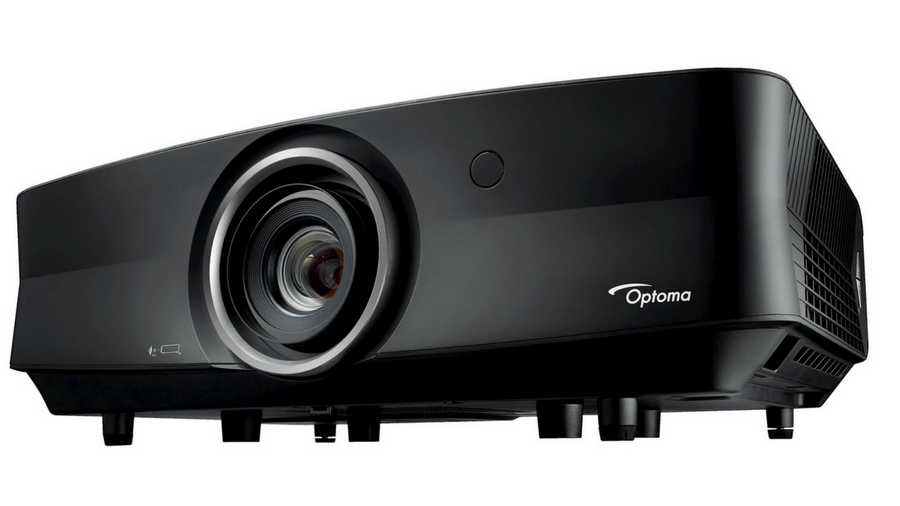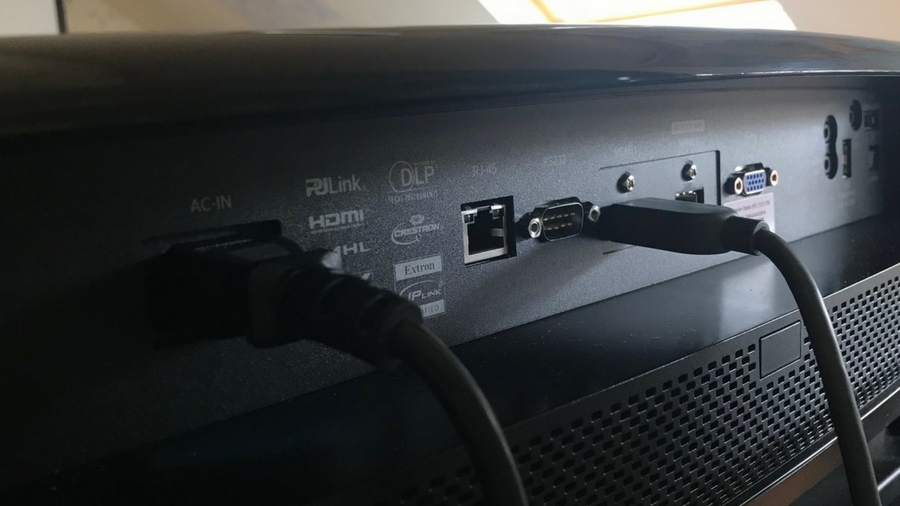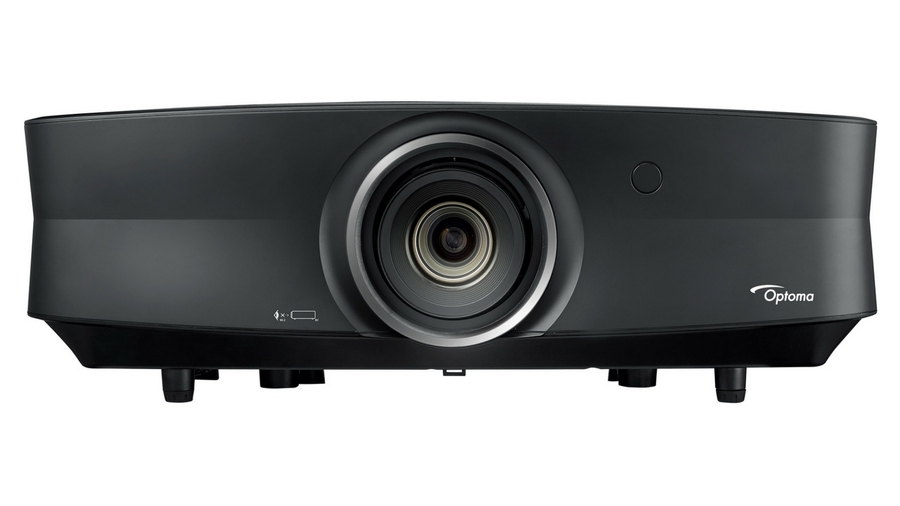TechRadar Verdict
Optoma's UHZ65 is not the everyman 4K projector that's currently in fashion, but rather an attempt to create a more luxe version for those who can afford it. Its laser light source works to produce big screen images with bags of 4K detail, decent colour and excellent upscaling. But it lacks a few niceties (notably a powered auto-focus and zoom, nicely designed onscreen menus, and a usable speaker system) that a projector of this price should include.
Pros
- +
Excellent 4K detail
- +
Bright in ambient light
- +
Great SD-HD-4K upscaling
- +
Low maintenance
Cons
- -
Huge price tag
- -
No quiet speaker option
- -
Average contrast & black levels
- -
No auto-focus or zoom
Why you can trust TechRadar
There is only one logical thing to do after you've created one of the most impressive and best value 4K HDR projectors around: You add lasers, of course.
One of three 4K DLP projectors from Optoma, the UHZ65 is virtually identical to the UHD60, which we used the term 'miraculous' to describe last year. In fact, the only major difference is that it users a laser light source.
At $4,499/£4,999/AU$8,999, the UHZ65 is not, technically speaking, a native 4K projector. A single-chip DLP projector based on the TI 4K DLP chip, it's got a resolution of 2716x1528, and then uses a clever pixel shift technique (also used by the likes of Acer, BenQ and Epson) to double the detail. The end result is a 3840x2160 pixel image but it's not necessarily a native one.
‘Faux’ 4K? Perhaps, but it does produce a terrifically detailed image.
However, the chief advantage of the UHZ65 over the UHD60 is its use of a laser phosphor light engine, which can reach 3000 lumens and copes with HDR images (in HDR10). What you're really paying for is the claimed 20,000 hours the UHZ65 will run for without any need to change the bulb. Compare that to the 10,000/15,000 hours the UHD60 will run in eco/dynamic modes. It's not an exact science, but the UHZ60 will probably run for about twice as long and, practically speaking, you'll never have to replace anything in its life ... but it's also about twice as expensive.
Are we really ready to abandon light bulbs for lasers? Let's find out.

Design
Measuring in at 498 x 331 x 141mm and weighing 9.3kg, the UHZ65 looks much the same as any other big home projector - it's big, it's bulky, it's gloss black, and it's got a host of inputs and outputs on its back.
Also hidden away back there are a couple of HDMI inputs, one of which can handle 4K HDR feeds (it's HDMI 2.0, so has HDCP 2.2), a standard VGA 15-pin port for attaching the PC, and both an RS232 and an RJ-45 port for integrating the UHZ65 into a home cinema control system.
In terms of audio, while you can find standard 3.5mm inputs and outputs for audio on-board, for the UHZ65 has its own basic sound system.
OK, so a couple of 5W speakers are hardly going to rock your world, but some will find them very useful (and, thankfully, such basic sound systems are becoming commonplace on all classes of home projectors). Sadly, the volume choices are either mute, loud, or very loud, so don't plan on using them late at night.
Although there's not much to say about the internal menu system on the UHZ65, which is rudimentary at best, you can add all the smart stuff you like via a Google Chromecast or Amazon Fire Stick-like device thanks to a powered USB slot on the reverse of the UHZ65.

Setup
Although it's likely to remain as the centrepiece to any 4K home entertainment setup, the UHZ65 relocates pretty easily.
Despite being housed inconveniently underneath a rather cumbersome lid on the top of the projector, it's got a vertical lens shift lever, which together with a rather big 1.6x zoom, makes aiming its images relatively easy at close quarters. That extra 15% vertical up or down makes placement of the UHZ65 easier, though horizontal lens shift would make it much easier still.
However, at this high price we had expected there to be a motorised auto-focus and zoom system. Yanking a few levers and shuffling the projector around a room to create a dead-on all feels a little too manual on such an expensive product.

Performance
Although its Cinema, HDR, HDR Sim, Game, Reference and Bright modes are all usable, out of the box its images do need a little tinkering, particularly for contrast.
Once you get things to how you like them, however, the UHZ65's eight megapixel images consistently contain bags of 4K detail, completely nullifying any thoughts about the 'faux' 4K that this projector technically relies upon. There is an UltraDetail option, but there's little need for the harsh image it creates.
If its impressive 4K detail lends instant wow factor to its images, it's limited to detail because while colours and thoroughly impressive, they're not drop-dead sensational. Does HDR 'pop' as much as on a high-end 4K TV? Not quite – no projector can match a super-bright TV in that regard – but it's close enough.

Used on an 80-inch screen, the UHZ65 produced a sparkling array of tone and textures and an all-round radiant look. Those red, blue and green lasers also combine to create more subtle effects, with complexions remaining realistic and never over-cooked. For anyone who thinks HDR is impressive, but just too darned bright on an expensive TV, the UHZ65's more cinematic treatment will impress.
There is some middling contrast and black levels to contend with, but when watching in a blackout, engaging the Dynamic Black option (on a weak setting) helped a bit. Movie fans watching in a blackout will benefit most, though another key feature on the UHZ65 – frame interpolation software – is aimed squarely at watching sport.
On the UHZ65 it's called PureMotion, and if used on one of its mid-strength settings, it brings a giddy fluidity to fast-moving sequences, but it also smoothes-out camera pans and gets rid of that irritating judder. My only criticism of PureMotion is that (like a lot of the image options), it's difficult to find quickly in the on-screen menus.
Even with some windows cracked open considerably, the UHZ65 in bright mode is able to produce a very watchable image from a football match broadcast in 1080i. Even further down the food chain, DVDs and of even low-quality YouTube videos look clean enough. Great upscaling like this is still as important a skill as any other.

Verdict
After a couple of years when anyone after 4K was advised to go through TV rather than projector, suddenly that's not true anymore. 4K projectors are now everywhere, and becoming a lot more affordable. Optoma's UHZ65, however, is not the everyman 4K projector that's currently in fashion, but rather an attempt to create a more luxe version for those who can afford it.
Its laser light source works to produce big screen images with bags of 4K detail, decent colour and excellent upscaling. But it lacks a few niceties (notably a powered auto-focus and zoom, nicely designed onscreen menus, and a usable speaker system) that a projector of this price should include.
Put simply, UHZ65 struggles to compete either on value or on high-end features. It may have a maintenance-free laser light source that effectively means you'll never have to think about replacing a bulb, but is that really worth paying twice as much money for?
- These are the best projectors of 2018
Jamie is a freelance tech, travel and space journalist based in the UK. He’s been writing regularly for Techradar since it was launched in 2008 and also writes regularly for Forbes, The Telegraph, the South China Morning Post, Sky & Telescope and the Sky At Night magazine as well as other Future titles T3, Digital Camera World, All About Space and Space.com. He also edits two of his own websites, TravGear.com and WhenIsTheNextEclipse.com that reflect his obsession with travel gear and solar eclipse travel. He is the author of A Stargazing Program For Beginners (Springer, 2015),

